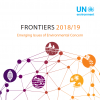
Will the cutting edge of genetic splicing techniques lead to a huge boon for human and environmental health, provided regulation can successfully control the risk of unintended ecological consequences? Will we act in time to prevent the further degradation of climate-critical permafrost peatlands and avert reaching the threshold of a potential runaway global greenhouse effect? Can we avoid the pitfalls of maladaptation to overarching climate change and move forward with wisdom to mitigate the worst effects – for all, not the few?
The Frontiers 2018/19 report covers five key emerging issues:
- the latest developments in synthetic biology;
- the critical advantages of landscape connectivity;
- the complex interactions and vulnerability of permafrost peatlands;
- the challenges of widespread nitrogen pollution; and
- the hazards of maladaptation in a world of climate change.
It emphasises the critical relationship between a healthy environment and healthy people, and how human activities often undermine the long-term health and ability of ecosystems to support human well-being. The report provides encouraging examples on how certain issues may be addressed by innovating and rethinking policy interventions, new solutions or adapting existing practices.
Ecological connectivity: A bridge to preserving biodiversity
Large-scale industrialization has resulted in widespread fragmentation of previously intact landscapes around the globe. From the clearance of richly populated rainforests to the damming of mighty, arterial rivers, the knock-on effect of isolated, impacted ecosystems is detrimental to the health of flora and fauna alike, and in severe cases, threatens species extinction. Landscapes are also not limited to the terrestrial realm as ecosystem connectivity extends beyond continental shores into marine seascapes and the oceans.
Initiatives to promote landscape connectivity are offering hope in various global locations, but much more focus in planning to reconnect habitat patches or preserve existing connectivity is needed. This is vital to preserving the remaining biodiversity and to protect the interlinked ecosystems on which we all depend. National efforts require expansion to the international level, as ecosystems are not bounded by country borders. From marine reserves to wildlife corridors and beyond, this wide-ranging chapter explores the issues of, and solutions to, fragmentation in the natural world and the imperative for joined-up thinking in planning for the preservation and conservation of biodiversity and species survival.
Permafrost peatlands: Losing ground in a warming world
With rising global temperatures, the Arctic is warming twice as fast as the global average and scientists are becoming increasingly alarmed at the accelerating rate of permafrost thaw. While research is ongoing, too little is currently known of the intricate relationships and dynamics between the perennially frozen ground that is permafrost and the insulating layer of dead plant remains – or peat – that covers a significant percentage of the Northernmost areas of our planet.
Permafrost thaw not only has direct impacts on the ecology and infrastructure of the peatland regions, it is also a potential ‘tipping element’ towards a runaway greenhouse effect. Preservation of these rich soil-carbon deposits is imperative to cushion the global effects of climate change and to avoid the worst effects and risks of unlocking these frozen assets, which keep carbon and other greenhouse gases sequestered underground and out of the atmosphere. Likely scenarios and the collaborative research urgently needed to ensure preservation of these crucial deposits are thoroughly explored in this chapter, from the ground up.
The nitrogen fix: From nitrogen cycle pollution to nitrogen circular economy
Nitrogen is one of the most abundant natural elements and largely benign in its unreactive forms. However, too much of a good thing can be detrimental, and excess nitrogen pollution has grave impacts on ecosystems and humans alike. In the form of nitrous oxide, it is 300 times more powerful than carbon dioxide as a greenhouse gas, in addition to the effects of various nitrogen compounds on air quality, ground and water, and the ozone layer.
A cohesive global approach to nitrogen management is needed in order to transform the nitrogen cycle into a sustainable, non-polluting, profitable circular economy. Although there has been some progress at the national level, a truly holistic approach to implementing effective nitrogen management strategies will require international cooperation. This highly informative chapter explores the detail and chemistry of the nitrogen pollution issue and potential routes to fixing it. If successful, the transition to a circular economy for nitrogen could be a trailblazer in wise scientific and policy decisions towards achieving the goal of a pollution-free planet.
For outlines of the other two chapters go to unenvironment.org.
Access the report here.
[This information originally appeared on unenvironment.org.]









